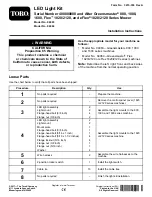
4-60
4181384 First Edition
ELECTRICAL
4
Component Testing
Electrical System and Component
Testing
General Information
Repair of the electrical system, for the most part, is
limited to the replacement of defective components or
wiring. When replacing electrical components or wiring
be sure to apply dielectric grease to all connector
terminals to prevent corrosion. Wiring diagrams are
provided in this section for troubleshooting and/or testing
the electrical system. Specific testing and replacement
information, where applicable, is also provided in this
section.
In addition to testing a suspected faulty component, it
may be necessary to check for shorts or breaks in the
wiring to the component. A common method of testing
wires or circuits is to perform a continuity check as
described in the following tests.
NOTE
Before performing any component or wiring tests, check
for corrosion and loose or missing connections.
If a component (switch, relay, etc.) is removed for testing
or replacement, make sure to identify and label all wires
so that the component can be installed correctly.
Continuity Test
1.
Identify and locate the wire or component to be
checked using the electrical schematic.
NOTE
Some meters may have a continuity tester setting that
uses a buzzer to indicate continuity. See the meter
operator’s manual for more information.
2.
If using a multimeter, set to read ohms or set meter to
continuity setting.
3.
Disconnect the ends of the wire being tested.
4.
Touch meter leads to the ends of the wire or to the
terminals of the component to be tested.
Does meter read less than 0.5 ohms, and/or does
the buzzer sound?
YES
The wire is good.
NO
Proceed to step 5.
5.
Use a known good jumper wire of the correct gauge
to bypass the wire in question.
6.
Test the function of the circuit.
Does the circuit now operate properly?
YES
Replace the wire.
NO
Continue testing other wires and
components in the circuit.
Resistance Test
1.
Identify and locate the wire or component to be
checked using the electrical schematic.
NOTE
On some meters it will be necessary to select an ohms
scale. Select an appropriate range for the component
being tested. Refer to the specifications listed in the
component test procedure.
2.
If using a multimeter, set to read ohms.
3.
Isolate (disconnect) the component to be tested from
the circuit to prevent a false reading through the
circuit.
4.
Connect the meter leads to the terminals of the
component being tested. Check the component test
procedure for specifications and additional test
conditions.
Does the resistance through the component
match the specified value listed in the test
procedure?
YES
The component is good.
NO
Replace the component.
Required Tools or Equipment
Digital Multimeter, Ohmmeter, or Continuity Tester
Required Tools or Equipment
Digital Multimeter or Ohmmeter
Summary of Contents for AR3
Page 1: ...AR 3 TR 3 Trim Mowers Technical Repair Manual AR30001 AR30002 TR30001 TR30002...
Page 3: ......
Page 7: ......
Page 9: ...1 2 4181384 First Edition SAFETY 1 Page Intentionally Blank...
Page 19: ...1 12 4181384 First Edition SAFETY 1...
Page 33: ...2 14 4181384 First Edition SPECIFICATIONS AND GENERAL INFORMATION 2 Page Intentionally Blank...
Page 73: ...4 16 4181384 First Edition ELECTRICAL 4 Page Intentionally Blank...
Page 85: ...4 28 4181384 First Edition ELECTRICAL 4 Page Intentionally Blank...
Page 147: ...4 90 4181384 First Edition ELECTRICAL 4 Page Intentionally Blank...
Page 200: ...HYDRAULICS 4181384 First Edition 6 9 6 Page Intentionally Blank...
Page 249: ...6 58 4181384 First Edition HYDRAULICS 6 Page Intentionally Blank...
Page 251: ...7 2 4181384 First Edition STEERING 7 Page Intentionally Blank...
Page 264: ...STEERING 4181384 First Edition 7 15 7 Page Intentionally Blank...
Page 265: ...7 16 4181384 First Edition STEERING 7...
Page 311: ...8 46 4181384 First Edition CUTTING UNITS 8 Page Intentionally Blank...
Page 331: ...9 20 4181384 First Edition ACCESSORIES AND MISCELLANEOUS REPAIR 9 Page Intentionally Blank...
Page 340: ......
Page 342: ......















































